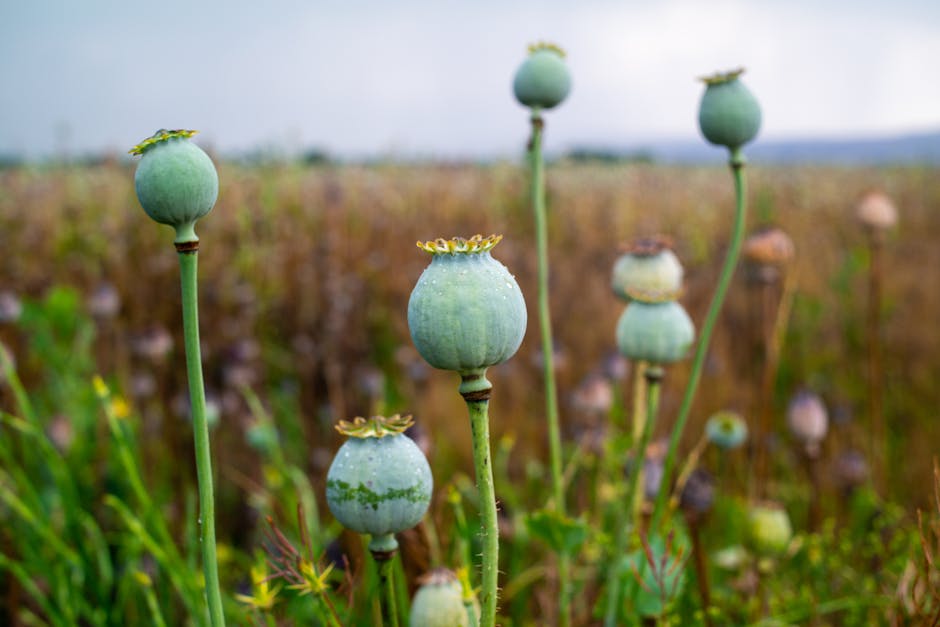- Your cart is empty
- Continue shopping
Papaver Somniferum: From Garden Beauty to Medicinal Marvel

Papaver somniferum, commonly known as the opium poppy or breadseed poppy, is a plant with a fascinating history and multifaceted uses. Because papaver somniferum holds such significance, here’s a quick overview:
- Opium poppy: Source of opium, used in pharmaceuticals.
- Breadseed poppy: Known for its edible seeds.
- Ornamental plant: Aesthetic appeal in gardens.
This species of poppy is cherished not only for its botanical beauty but also for its rich role in agriculture, medicine, and cultural history. Grown widely across the globe, this plant intrigues gardeners and health-conscious individuals alike, offering versatile seeds that are nutritious and delicious.
In addition to its aesthetic charm, the opium poppy holds great medicinal value, producing important narcotic components like morphine. While its cultivation for opium is heavily regulated, its seeds and ornamental appeal continue to make it a staple in gardens and kitchens worldwide.

The Botanical Marvel: Papaver Somniferum
Cultivation and Varieties
Papaver somniferum, or the opium poppy, is a remarkable plant with a unique blend of beauty and utility. Scientifically classified under the Papaveraceae family, this plant is native to the western Mediterranean region, including countries like Algeria, France, and Spain.
The flowers come in a variety of colors, adding a splash of beauty to any landscape. Beyond its ornamental use, this plant is also a significant agricultural crop.
They are a popular culinary ingredient, adding a nutty flavor and crunchy texture to baked goods. These seeds are completely safe and legal to consume, as they do not contain the narcotic properties of other parts of the plant.
However, it’s the plant’s role in opium production that makes it truly noteworthy. Opium, extracted from the poppy’s seed pods, is the raw material for powerful narcotic analgesics like morphine and codeine. These substances are crucial in the medical field for pain relief and sedation.
Legal Aspects and Restrictions
The cultivation of papaver somniferum is subject to strict regulations due to its potential for opium production. In the United States, the Controlled Substances Act governs the growth of opium poppies. According to this law, growing the plant for opium extraction is illegal without a special license from the Drug Enforcement Administration (DEA).
Internationally, the cultivation and trade of opium poppies are regulated by treaties such as the Single Convention on Narcotic Drugs. These regulations aim to control the production and distribution of opium to prevent misuse and illegal trafficking.
Despite these restrictions, growing opium poppies for ornamental purposes is generally allowed in many regions, including parts of the United States. However, gardeners should always check local laws to ensure compliance.
The opium poppy‘s journey from a garden beauty to a medicinal marvel showcases its dual nature—offering both aesthetic pleasure and potent pharmaceutical benefits. Whether admired in a garden or used in medicine, papaver somniferum remains a plant of enduring intrigue and importance.
Medicinal Uses and Benefits
Historical Context and Modern Applications
The opium poppy, scientifically known as Papaver somniferum, has been used for its medicinal benefits for thousands of years. Its history is deeply rooted in ancient civilizations, where it was valued for its powerful pain-relieving properties. The Sumerians, as early as 3,400 B.C., referred to it as Hul Gil, meaning the “joy plant,” highlighting its significance in their culture.
Morphine works by binding to receptors in the brain and spinal cord, reducing the perception of pain. It is often used in surgical settings and for patients with chronic pain conditions. Codeine, on the other hand, is less potent than morphine but is still widely used for its analgesic and cough suppressant properties. It is commonly found in prescription medications for moderate pain and cough relief.

The pharmaceutical industry relies heavily on the opium poppy for the production of these essential drugs. The demand for opium-derived medications has led to the development of specific poppy cultivars with high alkaloid content to maximize yield. This industry has grown alongside advancements in medicine, continually finding new therapeutic applications for opium alkaloids.
In modern times, the use of Papaver somniferum has expanded beyond traditional pain management. Research continues to explore its potential in treating various medical conditions. However, due to the addictive nature of opium derivatives, their use is carefully regulated to prevent abuse.
This delicate balance between using the medicinal benefits of opium and preventing its misuse underscores the importance of Papaver somniferum in both historical and contemporary medicine. As we continue to learn more about this remarkable plant, its role in healthcare remains as vital as ever.
Papaver Somniferum in the Garden
Growing Conditions and Care
The Papaver somniferum, commonly known as the opium poppy, is not just a source of medicinal compounds but also a stunning addition to any garden. Known for its vibrant blooms and unique seed pods, it offers both beauty and versatility.
Ornamental Beauty
These blooms come in a range of colors, from deep reds to soft pastels, and can add a splash of color to any garden setting. The flowers typically have a delicate, crinkled texture, making them a standout feature in floral arrangements.
Cultivation Tips
To successfully grow Papaver somniferum, consider its preferred growing conditions:
- Warm Climates: This plant thrives in warm, dry climates. It is well-suited to regions with plenty of sunshine and minimal rainfall.
- Soil Requirements: The poppy prefers well-drained soil, rich in nutrients. If your soil is heavy or clay-like, consider adding sand or organic matter to improve drainage.
- Sowing Tips: Seeds should be sown directly into the soil in early spring or late fall. They need light to germinate, so avoid covering them with soil. Instead, gently press them into the soil surface.
Decorative Uses
Beyond their garden appeal, the dried seed pods of Papaver somniferum are popular in crafts and decorations. Their unique shape and texture make them a favorite in dried floral arrangements, adding a rustic touch to home decor.
Pest Management
While Papaver somniferum is relatively hardy, it is not immune to pests:
- Flea Beetles: These can perforate the leaves of young plants. Monitoring and using organic sprays can help manage them.
- Aphids: These sap-sucking insects can affect flower buds. Regular inspection and natural predators, like ladybugs, can keep aphid populations in check.
Managing pests effectively is crucial for maintaining healthy plants. Additionally, early sowing and proper plant care can reduce the risk of diseases like leaf blight, caused by the fungus Helminthosporium papaveris.
Incorporating Papaver somniferum into your garden not only improves its visual appeal but also connects you to a plant with a rich history and multifaceted uses. Whether you’re growing it for its beauty or for its historical significance, this poppy is sure to be a garden favorite.
Frequently Asked Questions about Papaver Somniferum
Is it legal to own Papaver Somniferum?
The legality of owning Papaver somniferum, or opium poppy, varies by country and even within regions of a country. In many places, it’s legal to grow these poppies as ornamental plants or for their seeds, which are used in cooking. However, cultivating them for opium production is strictly regulated and often illegal. In the United States, for example, growing opium poppies without a license from the Drug Enforcement Administration (DEA) is prohibited due to their narcotic potential. Always check local laws before planting or purchasing Papaver somniferum.
What drug is obtained from Papaver Somniferum?
Papaver somniferum is the source of several powerful narcotic analgesics. The most well-known drugs derived from this plant are morphine and codeine. These compounds are crucial in the medical field for pain management. The plant also produces thebaine, a precursor for synthesizing other opioids like oxycodone.
Does Papaver Somniferum have hallucinogenic properties?
Papaver somniferum itself does not have hallucinogenic properties. However, its derivatives, particularly opium and its processed forms like heroin, can produce euphoria and altered states of consciousness. While the plant has significant medicinal value, its misuse can lead to addiction and other severe health issues.
Conclusion
At Primiumpoppypods.com, we take pride in offering Papaver somniferum products that highlight their unique benefits and uses. Our organic poppy seeds are not just for culinary enthusiasts but also for those who appreciate the health benefits and decorative potential of this remarkable plant.
Health Benefits
Poppy seeds are a powerhouse of nutrients. They are rich in essential omega-6 fatty acids, calcium, magnesium, and fiber, contributing to a balanced diet. Some studies suggest that when used responsibly, poppy seeds can promote sleep and help alleviate anxiety. However, it’s important to consume them in moderation to avoid any potential health issues.
Decorative Uses
Beyond their nutritional value, Papaver somniferum pods are a favorite among decorators and crafters. The dried seed pods add a natural touch to floral arrangements and crafts, offering a rustic charm that is both timeless and versatile. They are especially popular for creating visually striking displays that capture the beauty of nature.
For those interested in exploring the full range of our offerings, we invite you to visit our pop-up pod selection. We provide fast delivery and trusted products to ensure you get the best quality every time.
In summary, Papaver somniferum is a botanical marvel with a rich history and diverse applications. Whether you’re seeking to improve your culinary creations or add a decorative flair to your home, our organic poppy seeds and pods are a perfect choice. Explore the possibilities with Primiumpoppypods.com and accept the beauty and benefits of this extraordinary plant.
